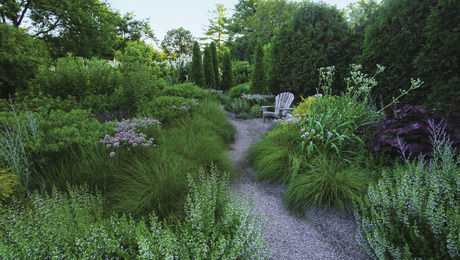
Naturalistic garden design catches all the headlines, but until recently it seemed removed from the reality of most home gardeners. Yet no matter how your garden grows today, it can easily include more life tomorrow by virtue of thoughtful, intentional planting. While fashions wax and wane, naturalistic style endures because it follows the principle that the art of gardening isn’t made merely from fleeting properties like texture and color but also from the dynamic performance of plants throughout time. The garden is no longer a static picture, but rather a cinematic one.
To make a wildflower garden doesn’t require that you give anything up. This type of garden features more plants, not fewer, with a generous foundation of species that are native to your region. At the outset, your best efforts will develop from calculated guesses based on some site intelligence. Your assumptions don’t need to be foolproof. Instead, they are more like hedged bets; you hope you are right more than you are wrong, and there are always opportunities for learning and more growing.
Take inspiration from your local ecosystem

Whether you are starting with a blank slate or reconceiving an existing garden, the act of grounding yourself in place opens deeper possibilities for your plantings. No matter your climate or geography, your local flora offers an unfolding catalog of planting ideas that are authentic to place. Even if you are not a weekend hiker or amateur botanist, you can start to create palettes of plants that grow in similar conditions. Making them look good borrows from all the instincts of garden design you already know so well—color, texture, form, and seasonality. But instead of starting with what looks good, you are beginning with what works together based on plants’ adaptations to their habitats. Climate change may well upend some of these assumptions, so it doesn’t hurt to think somewhat liberally about how and where you extend the boundaries of nativity. Related species from southerly regions in otherwise native genera may have merits as the climate shifts with time.

Beyond the plants that are native to your area, your local ecosystem also includes the footprint you live on, including its features and immediate history. The landscapes that surround new construction often reflect disturbance, including altered topography, compacted soil, and denuded tree canopies. Old home sites may offer more spatial complexity, which favors a greater array of biodiversity—particularly insects, birds, and amphibians. Regardless of the particulars, these clues can begin to guide your garden into something truly authentic to place while also saving you headaches in the long run because you chose to look honestly at what the site offered.
Tip: Get more of your favorites

Collecting seed for future plantings is an excellent way to build up populations of plants that perform well in your garden. Plants propagated from seed have some genetic diversity, making them more adaptable than commercially grown clones.
Evaluate, adjust, and add to your design
After a few seasons you can begin to measure your plantings against your original guesses and assumptions. Noting which plants have thrived offers as many insights as identifying which have not. Lean into the best performers either by increasing their numbers where warranted or adapting insights into their success with similar species. It’s OK to walk away from plants that just aren’t meant for your place. It’s not about you; it’s about them.

Regardless of plant performance, strive to cultivate a garden that remains legible and diverse. In a diverse cohort of plants, the contributions of each species to the biomass is maximized. Every plant has a role to play and a niche to fill. But diversity can also challenge legibility by offering us too much to see and understand. Keeping the visual order helps us communicate our intentions to others—for example, by creating orderly frames around wilder plantings with mowed edges, formal hardscape boundaries, or clearly defined paths. Ecological vibrancy is the result of a conjunctive mindset—your garden can be both beautiful and functional.
The best advice for any ecological gardener is this: Just keep planting. Planting is a powerful act of intervention, a unique form of disturbance that keeps gardens vibrant and diverse. When we plant, we intend for more plants, much as wild plants going to seed each year ensures the perpetuation of those species if conditions prove favorable. But this liberation to keep growing and changing comes with a gentle warning: The tapestry of a garden, while perhaps ever changing, is as important as any one thread. Part of your mission as an ecologically inclined gardener is to foster resiliency, to cultivate harmony between what looks good enough and how plants work with the nature of place. This isn’t a finite game with a finish line; rather, it’s an infinite game always played. Suspend fussiness and watch closely. Living with your wilder garden guarantees you’ll enjoy all the life it supports.
Kelly D. Norris is the author of New Naturalism: Designing and Planting a Resilient, Ecologically Vibrant Home Garden.
Photos, except where noted: Kelly D. Norris
Fine Gardening Recommended Products

Berry & Bird Rabbiting Spade, Trenching Shovel
Fine Gardening receives a commission for items purchased through links on this site, including Amazon Associates and other affiliate advertising programs.

The Crevice Garden: How to make the perfect home for plants from rocky places
Fine Gardening receives a commission for items purchased through links on this site, including Amazon Associates and other affiliate advertising programs.

Planting in a Post-Wild World: Designing Plant Communities for Resilient Landscapes
Fine Gardening receives a commission for items purchased through links on this site, including Amazon Associates and other affiliate advertising programs.




















Comments
Log in or create an account to post a comment.
Sign up Log in